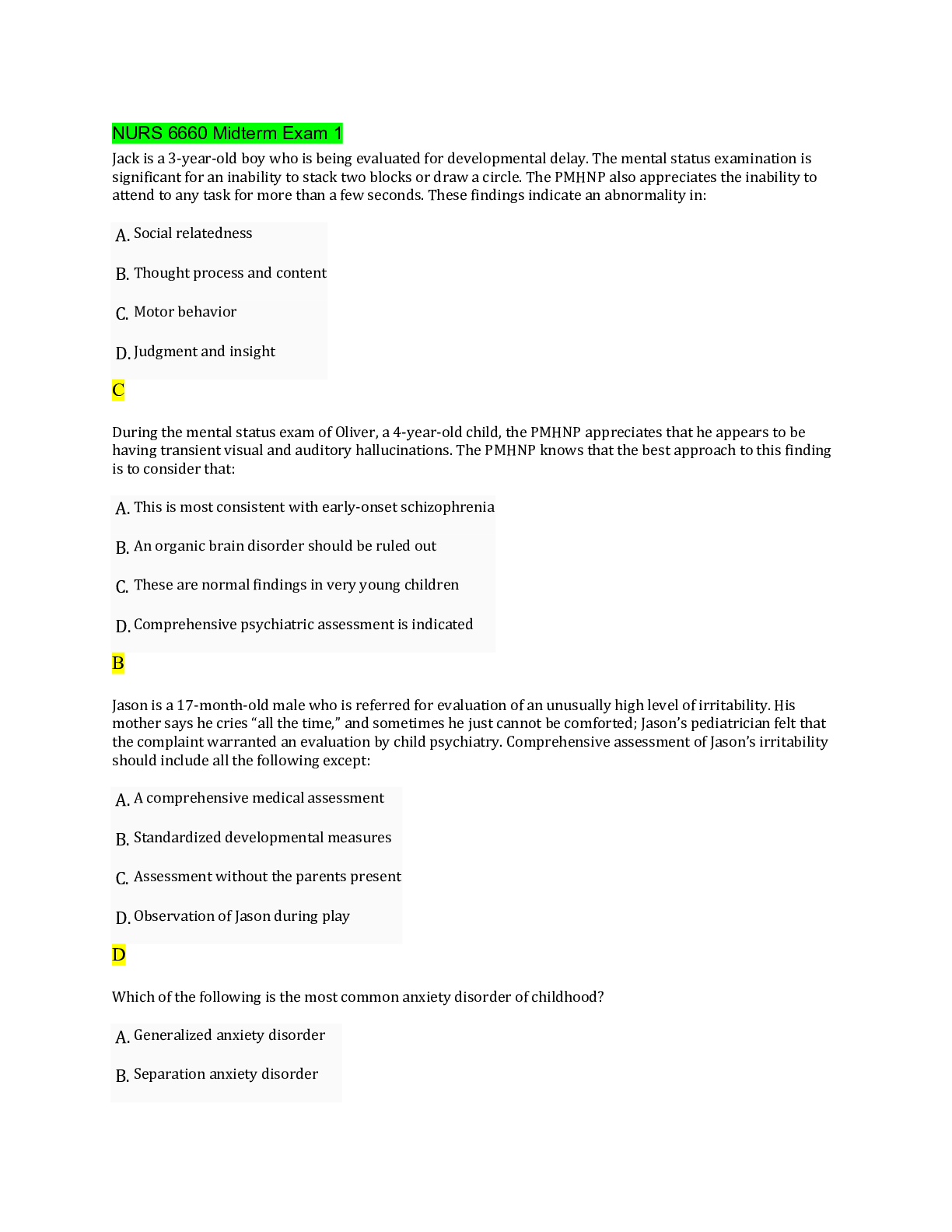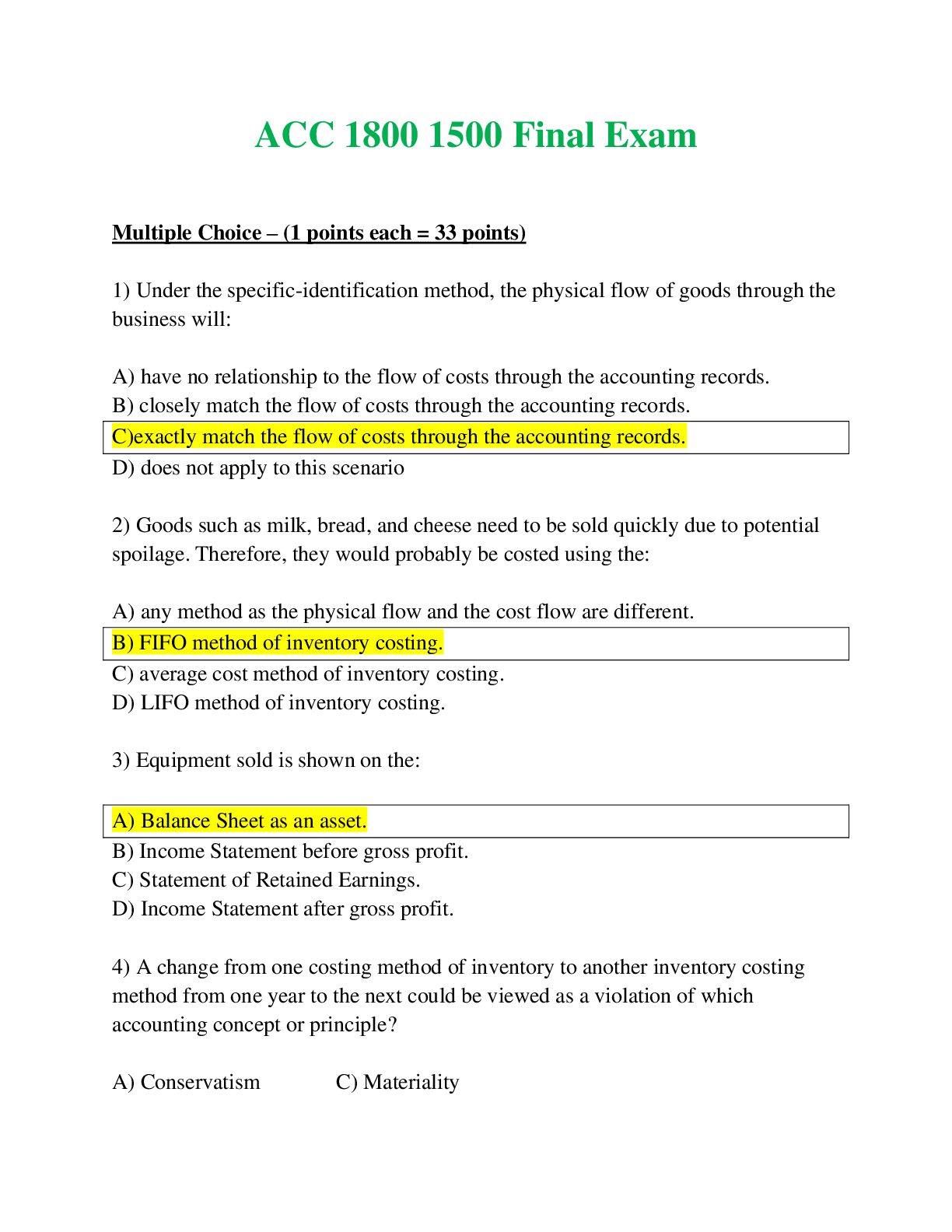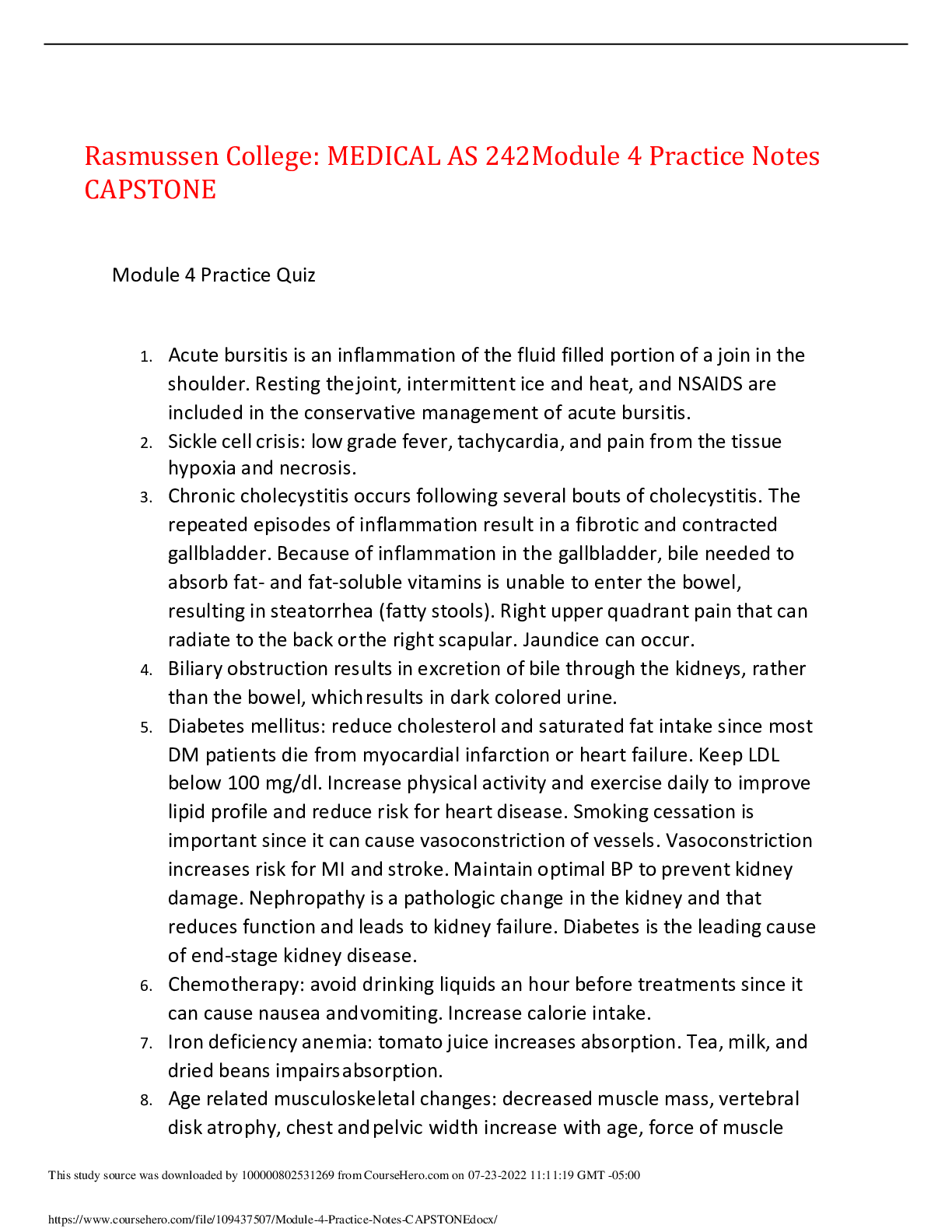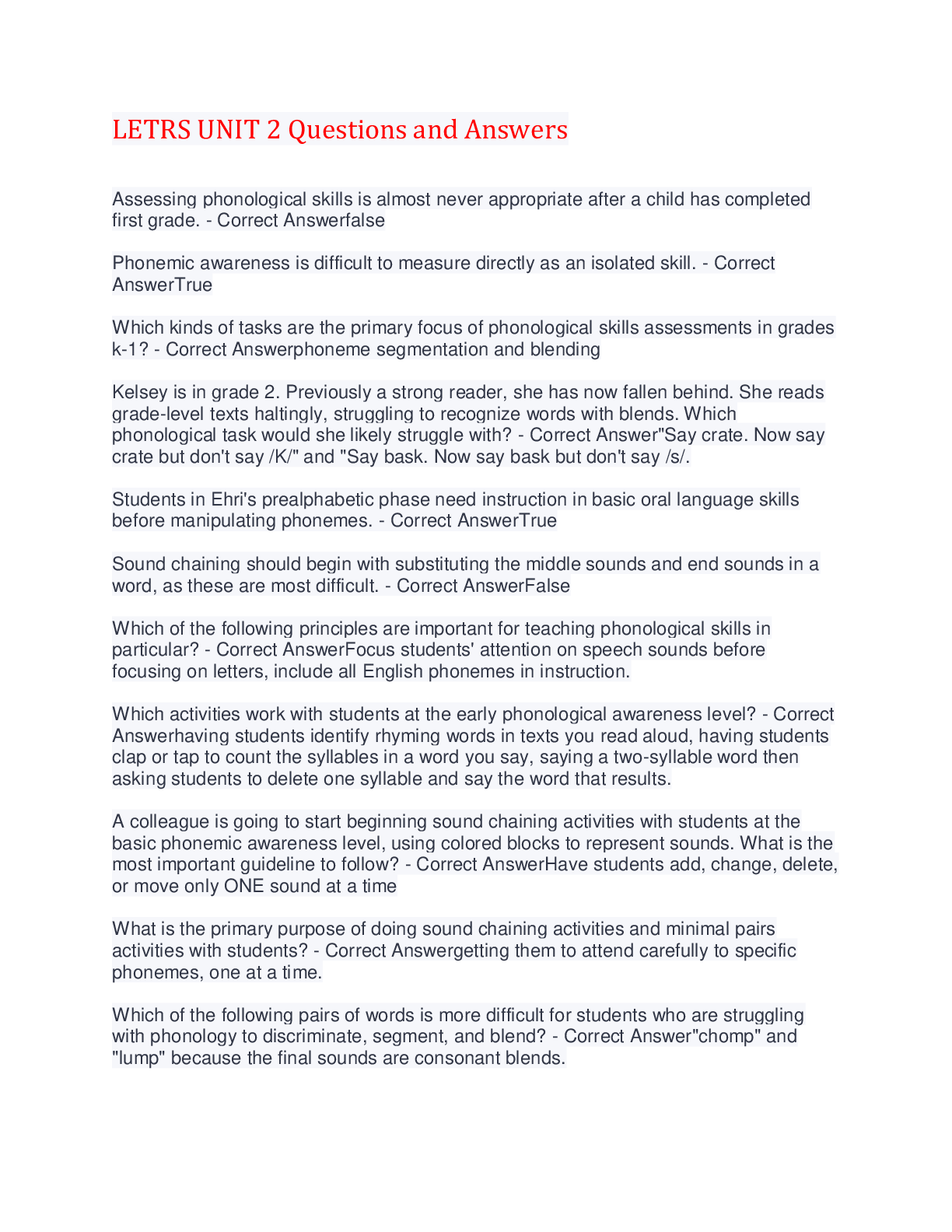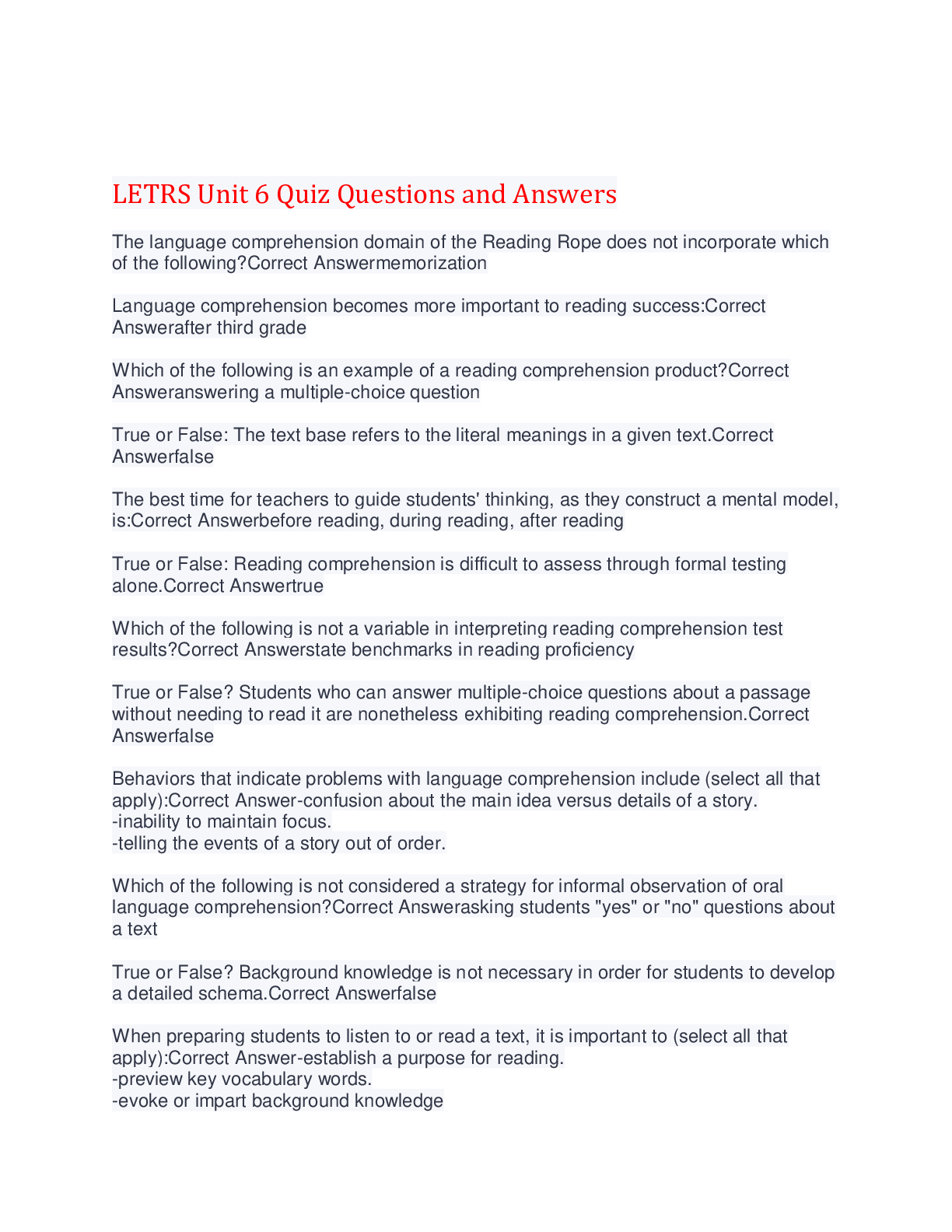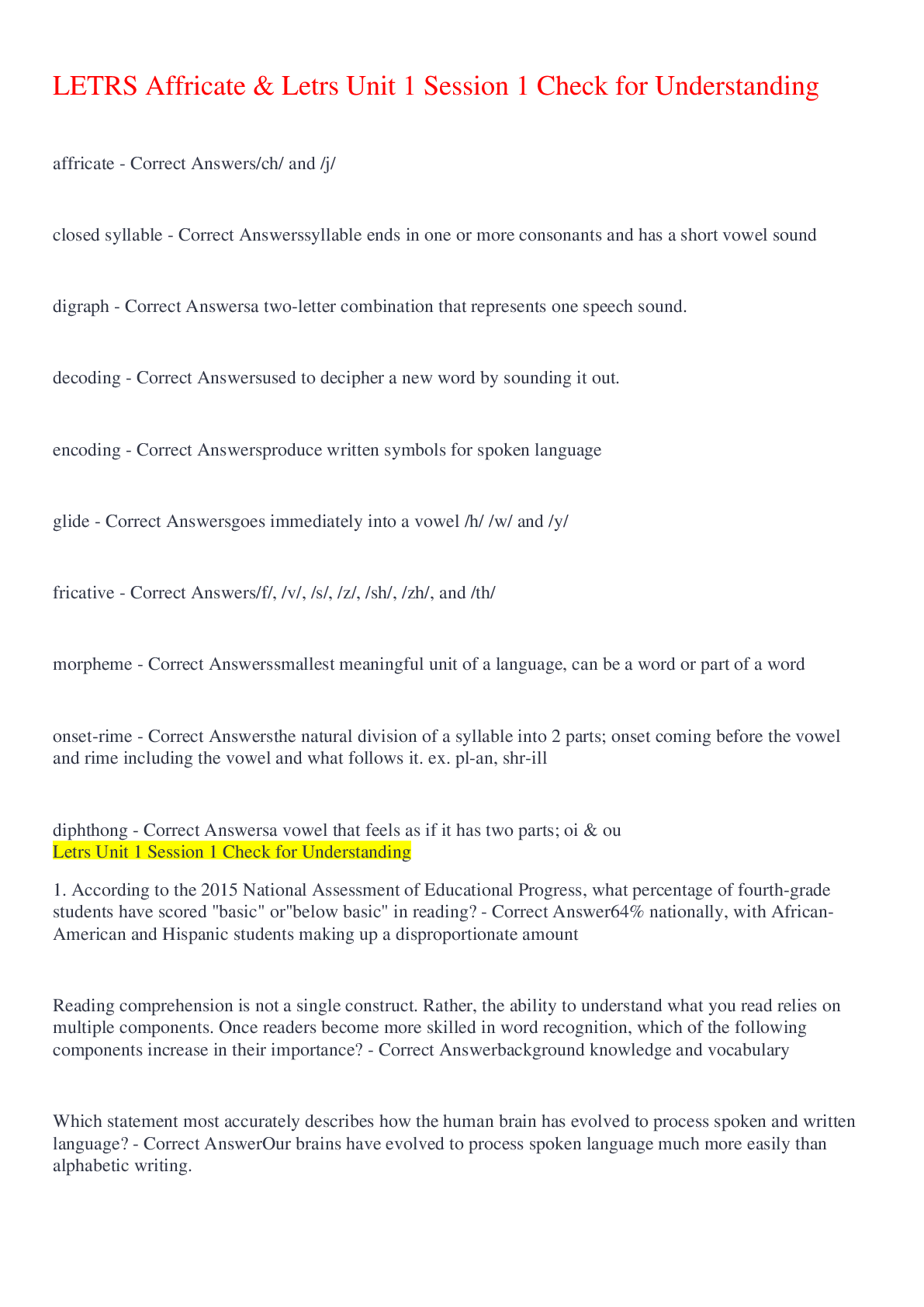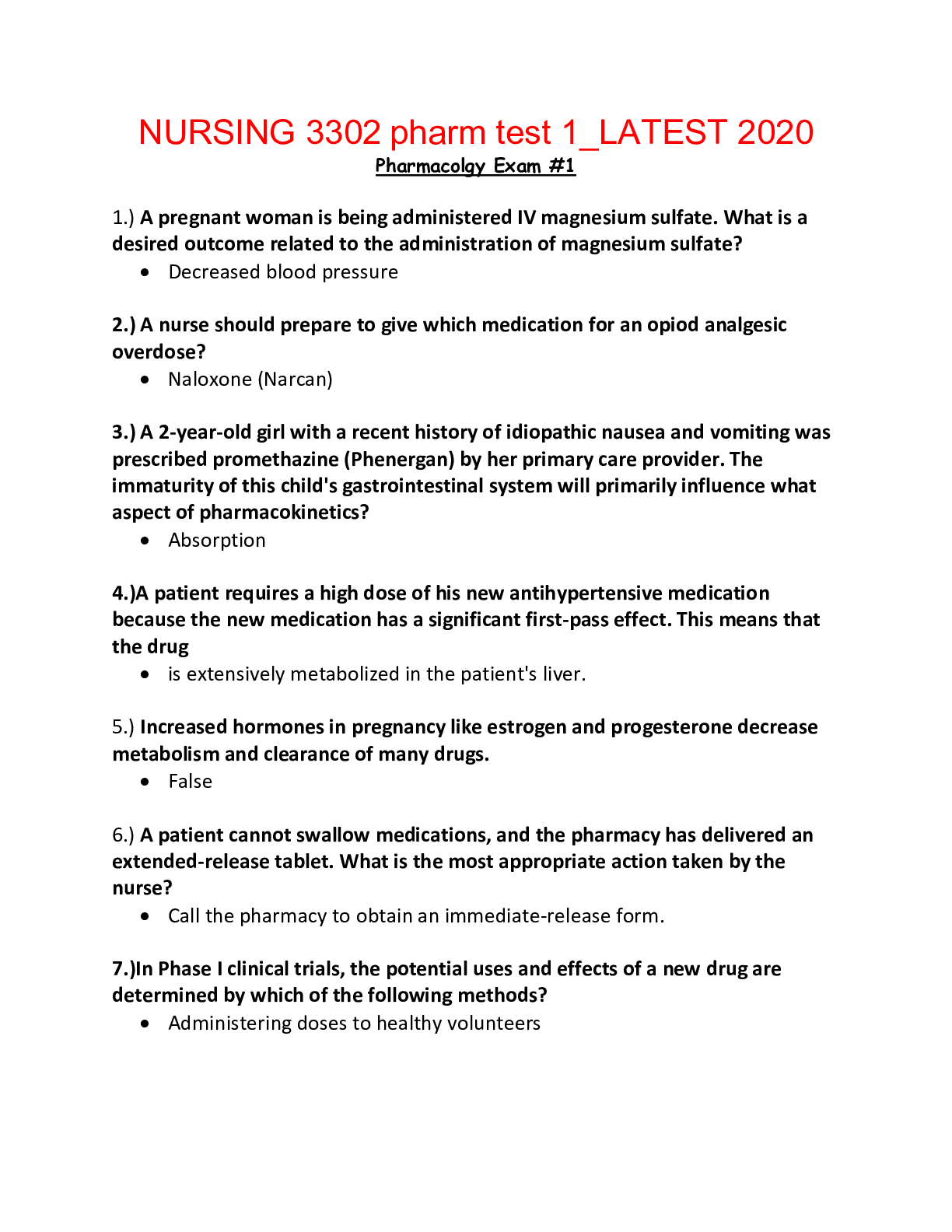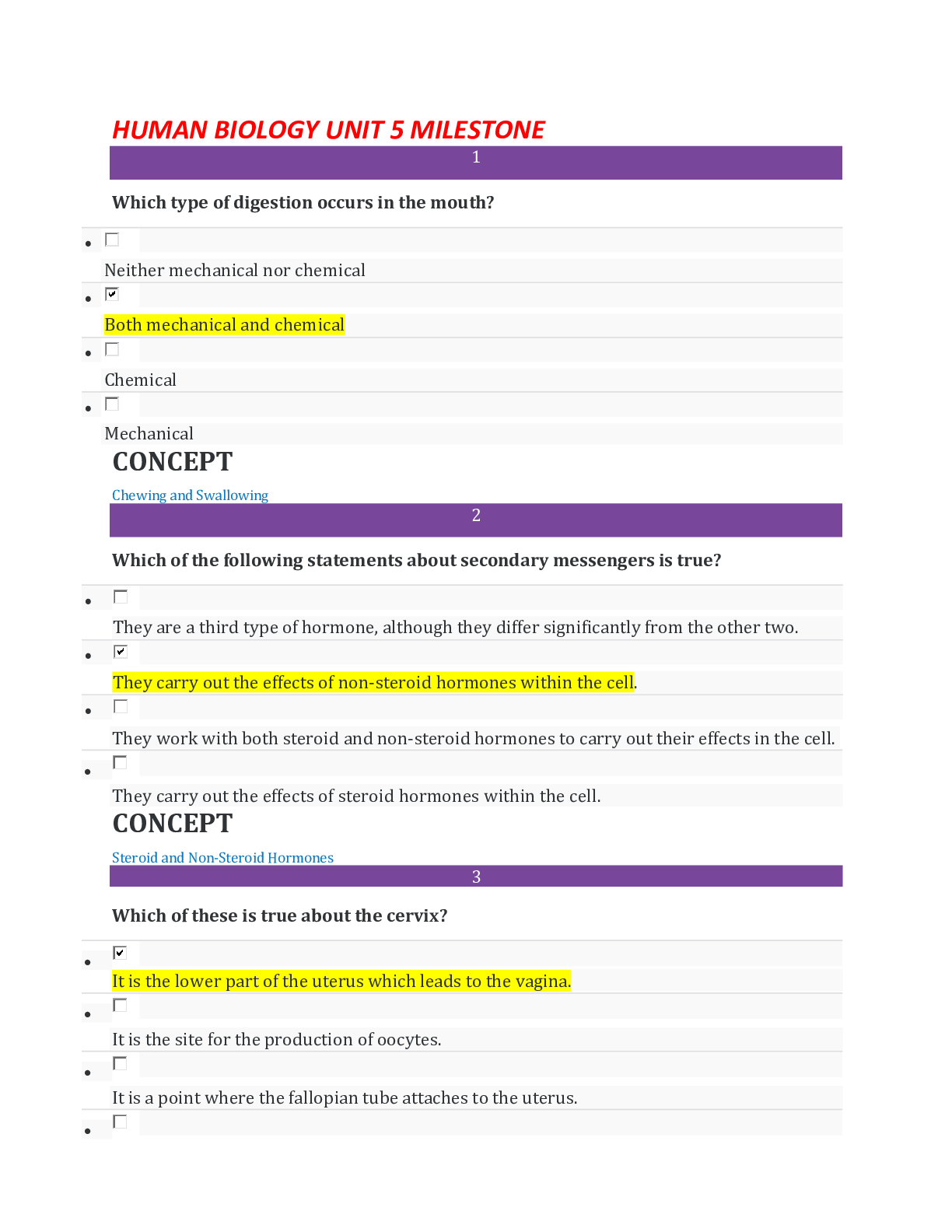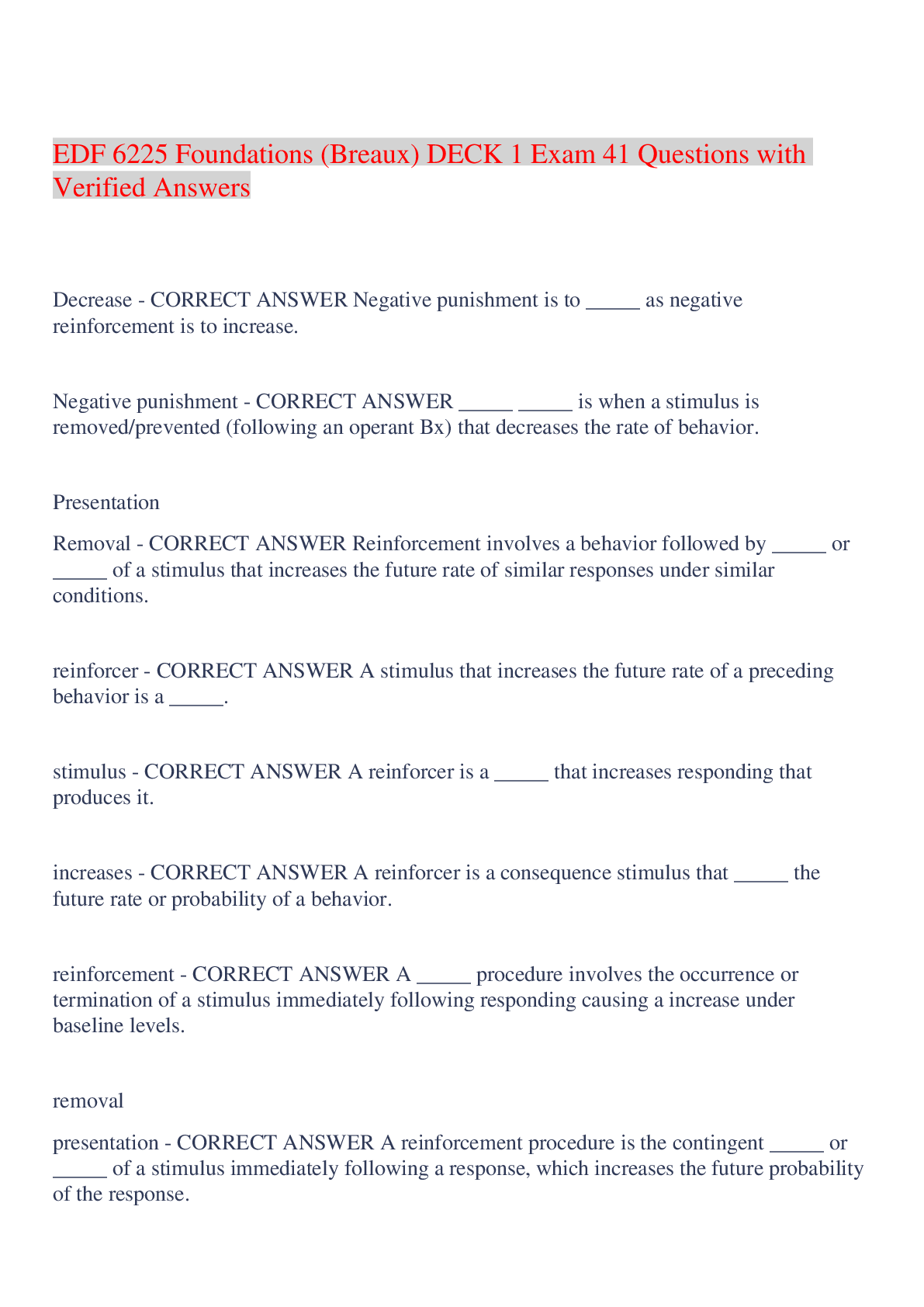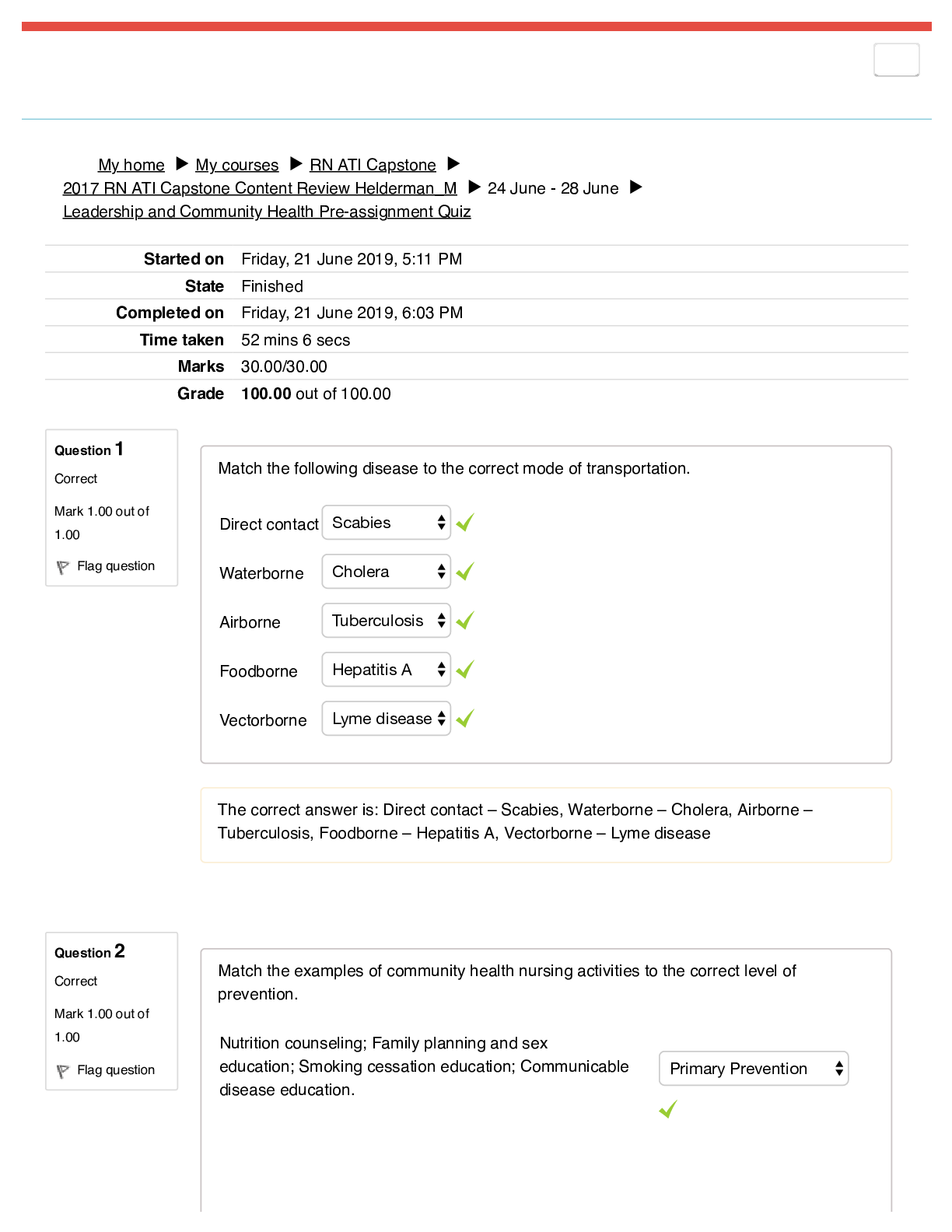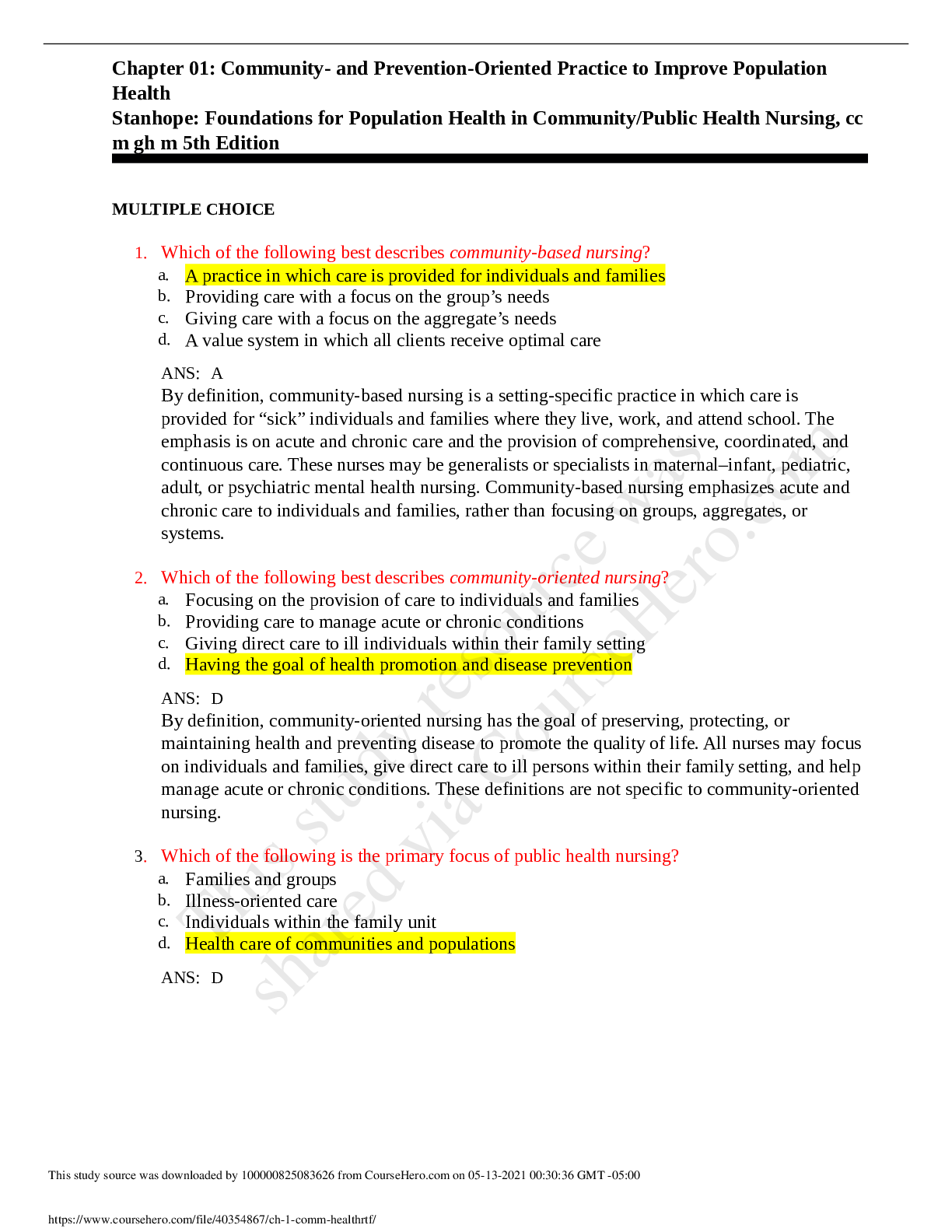*NURSING > EXAM > Chapter 04: Ethics in Public and Community Health Nursing Practice Stanhope: Foundations for Populat (All)
Chapter 04: Ethics in Public and Community Health Nursing Practice Stanhope: Foundations for Population Health in Community/Public Health Nursing, 5th Edition,100% CORRECT
Document Content and Description Below
Chapter 04: Ethics in Public and Community Health Nursing Practice Stanhope: Foundations for Population Health in Community/Public Health Nursing, 5th Edition MULTIPLE CHOICE 1. Which of the ... following is generally considered to be nursing’s first code of ethics? a. Nightingale Pledge b. Code for Professional Nurses c. Code of Ethics for Nurses d. Principles of the Ethical Practice of Public Health ANS: A The Nightingale Pledge is generally considered to be nursing’s first code of ethics. After the Nightingale Pledge, the Code for Professional Nurses was formally adopted by the ANA House of Delegates in 1950. It was amended and revised five more times, until, in 2001 the ANA House of Delegates adopted the Code of Ethics for Nurses with Interpretive Statements.The Principles of the Ethical Practice of Public Health was approved in 2002. 2. A nurse didn’t know what to do when faced with a particular ethical dilemma because an option that would have a good outcome didn’t seem possible. The nurse decided to talk to the agency supervisor and decide what action to take. Which of the following best describes the nurse’s actions? a. Appropriate, because the supervisor is responsible for the nurse’s choices b. Intelligent, because the supervisor has access to resource persons (clergy, physicians, administratorNs) wRho ImigGht kBno.wCof Moptions the nurse hadn’t considered c. Justified, because this provides an opportunity to discuss the issue but the nurse maintains responsibility for the decision d. Wise, because the supervisor would be more knowledgeable concerning agency priorities and traditional practices ANS: C Ethically, each nurse is responsible for his or her own decisions and cannot avoid ethical accountability by relying on obedience to a supervisor or any external rule or policy. The supervisor is not responsible for the nurse’s choices, the nurse must maintain responsibility for his/her own decisions. The nurse should have access to the same resources as the supervisor and should have similar knowledge as the supervisor. 3. Which of the following is the first and most crucial step in a generic ethical decision-making process? a. Assess the context or environment in which the decision must be made. b. Consider the various ethical principles or theories. c. Identify the ethical issues and dilemmas. d. Make a decision and act on it. ANS: C The first step in the ethical decision-making framework is to identify the ethical issue or dilemma. After the first step of identifying the ethical concern, the following steps are: (2) place the ethical issue or dilemma within a meaningful context, (3) obtain all relevant facts, (4) reformulate ethical issues or dilemmas, if needed, (5) consider appropriate approaches to action or options, (6) make the decision and take action, and (7) evaluate the decision and action. 4. A nurse is asked to meet with a family who recently immigrated from Botswana (Africa). After the physician tells the husband the wife’s diagnosis of breast cancer, the family thanks the physician and starts to leave. Ethically, which of the following is the nurse’s most important action? a. Emphasizing that the family must set up a surgical appointment for the wife immediately b. Assessing the family’s current living situation, including insurance and other assets c. Educating the family concerning the usual treatment and the prognosis of breast cancer d. Interviewing the family concerning their perspective of the threat to the family’s well-being ANS: D The United States is a multicultural nation with diverse ethnic groups and diverse values. Before any intervention can be made, the health care professionals must understand the family’s cultural, psychological, social, communal, and environmental contexts, because these contexts affect the way issues are formulated and decisions are made. Consequently, it is crucial to interview the family to determine their understanding of the situation before deciding what, if any, intervention must be made. In many cultures the family, rather than the individual, is the unit of primNaryRconIcernG. SBett.inCg uMp a surgical appointment immediately would not be an appropriate action for the nurse to take as this would be a premature action for anyone who has just been told that she has cancer. Assessing the family’s current living situation would not be the first concern of the nurse; the first concern should focus on the family’s well-being. After assessing the family’s well-being, the next action of the nurse may be to educate the family about the treatment and prognosis of breast cancer. 5. The nurse learns that a family has declined an elective medical intervention for a health care problem because paying for the care would drastically reduce the family’s resources and ability to meet the needs of other family members. Ethically, which of the following actions should be taken by the nurse? a. Appreciate that the family has made the decision that it feels is best and take no further action if it is clear the family has made an informed choice. b. Stress that each individual in society has a right to health care and the family will have to create some way to raise funds for the needed treatment. c. Talk to the media to see whether a campaign to raise funds for the family can be created. d. Try to convince the agency to give the care for free, even if it means economic stress for the agency, because the medical need is obvious. ANS: A According to Callahan, although the nurse may attempt moral persuasion to change the family’s values, in the absence of immediate and grievous harm, no ethical requirement exists to interfere with the family’s values. Because there is no immediate or grievous harm, it is not in the best interest of the nurse to interfere with the family’s decision. Thus, the other answers are not an appropriate action for the nurse to take. 6. Some nurses are debating about the appropriate action to take in relation to a particular family. The father is ill, and the other family members have chosen to continue working rather than take time off to care for the ill family member. One nurse states, “It is a wife’s responsibility to care for an ill husband.” Which of the following ethical approaches is being used by this nurse? a. Consequentialism b. Communitarianism c. Deontological ethics d. Principlism ANS: C The nurse is focusing on duty, which is a deontological approach based on the moral obligation to engage in certain actions. The nurse is focusing on duty, which is a deontological approach based on the moral obligation to engage in certain actions. 7. Some nurses are debating about the appropriate action to take in relation to a particular family. One member of the family is ill, and the other family members have chosen to continue working rather than take time off to care for the ill family member. One nurse states, “The whole family is being affected and will fall apart if they don’t focus on their family’s needs first before anything else.” Which of the following ethical approaches is being used by this nurse? a. Communitarianism b. Deontology c. Principlism d. Utilitarianism ANS: D NURSINGTB.COM By focusing on the whole family, not individual members, and the consequences or outcomes for the whole family during this time of stress, the nurse is taking a utilitarian approach. Principlism relies on these ethical principles to guide decision making. Communitarianism is similar to virtue ethics and looks at the relationship and respoinsibility between the individual and the community. The ethical approach of deontology describes adhering to moral rules or duty rather than to the consequences of the actions. 8. Some nurses are debating about the appropriate action to take in relation to a particular family. One member of the family is ill, and the other family members have chosen to continue working rather than take time off to care for the ill family member. One nurse states, “But it doesn’t have to be an either/or situation. Perhaps each family member could take a turn calling in sick just 2 or 3 days. That way they could all take a turn at helping and yet not upset their employers. Wouldn’t that be fair?” Which of the following ethical approaches is being used by this nurse? a. Communitarianism b. Deontology c. Principlism d. Utilitarianism ANS: C The nurse is focusing on ethical principles—in this case, beneficence (do good for the ill family member), nonmaleficence (do no harm, even to the employer), and justice (everyone takes a turn and shares equally). Communitarianism is similar to virtue ethics and looks at the relationship and respoinsibility between the individual and the community. The ethical approach of deontology describes adhering to moral rules or duty rather than to the consequences of the actions. Utilitarianism is a consequentialist ethical theory associated with outcomes or consequences in determining which choice to make. 9. Some nurses are debating about the appropriate action to take in relation to a particular family. One member of the family is ill, and the other family members have chosen to continue working rather than take time off to care for the ill family member. One nurse states, “It’s not up to us; it’s the family’s decision. They know what is best for them.” Which of the following ethical approaches is being used by this nurse? a. Communitarianism b. Deontology c. Principlism d. Utilitarianism ANS: C The nurse is using an ethical principle, namely autonomy, in which each person or group can choose those actions that fulfill its values and goals. Therefore, the nurse is using principlism—that is, basic principles are the basis of the nurse’s actions. Communitarianism is similar to virtue ethics and looks at the relationship and respoinsibility between the individual and the community. The ethical approach of deontology describes adhering to moral rules or duty rather than to the conseqNuUenRcSesIoNf tGheTaBc.tioCnOs.MUtilitarianism is a consequentialist ethical theory associated with outcomes or consequences in determining which choice to make. 10. Which of the following is the dominant issue in ethical debate around an issue such as continuing or withdrawing treatment in acute health care? a. Doing what is best for the community b. Doing what is best for the family c. Obeying legal mandates d. Upholding ethical principles ANS: D In acute care settings with a single localized issue, the primary ethical principles are usually applied, with patient autonomy being the dominant or most crucial principle. Upholding ethical principles should be the first consideration before obeying legal mandates or doing what is best for the community or family. 11. The staff cannot reach an agreement on what is the right thing to do in relation to a specific patient. Which of the following approaches should the nurse use in personally deciding what is right? a. Do whatever will not get the nurse in trouble with employer. b. Do whatever is supported by an ethical expert, such as the hospital chaplain. c. Do whatever the nurse would recommend to anyone in a similar situation. d. Do whatever the nurse supervisor would feel comfortable reporting to administration. ANS: C One of the rules in deontological decision making is to determine whether the proposed actions can be generalized so that all persons in similar situations are treated similarly. In the same way, principlism suggests the nurse examine the context and make the decision that can be morally justified within that context. In order to apply the deontological ethics decision process the nurse must first determine the moral rules that serve as standards by which individuals can perform their moral obligations, examine their own personal motives, and then determine wheter the proposed actions can be generalized. Doing whatever will not get the nurse in trouble, whatever is suppported by an ethical expert, or whatever the nurse supervisor feels comfortable with is not an appropriate way to make an ethical decision. 12. A man entered the emergency department bleeding profusely and screaming, “I’ve got to see a doctor right now! I’ve got a right to see a doctor! I’m hurt. You have to take care of me!” Which of the following premises would ethically justify such a demand for immediate attention? a. All hospitals receive federal money and all capable employed adults pay taxes, so all adults have a right to what their tax money has purchased. b. Saving an individual’s life improves society and upholds tradition. c. Our society believes that all persons should be treated equally and that basic needs, such as not dying if death can be avoided, should be met. d. The man has a property right to his own body, and the government is responsible to ensure that property rights are protected. ANS: C The ethical theory of egalitarianism suggests that everyone is entitled to equal rights, equal treatment, and an equal share of the goods of society—and that the government’s role is to ensure this happens, at least oNnUaRbSasIicNleGvTelB. T.hCerOefMore, the man has a right to emergency care. Hospital funding and use of tax payer money does not demonstrate the use of an ethical principle. Saving an individual’s life may or may not improve society. There is not an ethical principle that states that the man has a property right to his own body. 13. From an ethical standpoint, what is the problem with the belief that everyone should receive his or her fair share, that life should always be fair, and that everyone should make his or her own decisions? a. With this belief, the needs of society as a whole are ignored. b. Insufficient resources exist to give everyone a fair share. c. This belief leads to a propensity for some people to like to be taken care of. d. Some people think they deserve more than others. ANS: A All principles of justice focus on the individual, which ignores the needs of society as a whole. The rights of an individual may conflict with the rights of the community as a whole. It is recognized that distribution should be based on what needs and deserves there is considerable disagreement that exists when considering what these terms mean in the context of fairness. 14. A physician refuses to order pain medication for a drug addict who has been severely injured in a car accident. When reminded by nurses that pain medication has not been ordered, the physician merely replies that the patient’s suffering from the pain of his injuries will build character and that the addicted patient needs to get off drugs. Which of the following ethical theories is the physician using (or misusing)? a. Consequentialism b. Communitarianism c. Deontological ethics d. Virtue ethics ANS: D Virtue ethics emphasizes practical reasoning applied to character development. Although such action by a care provider is paternalistic and unethical on many grounds, the physician may truly be concerned with enabling the injured addict to learn from his experience and possibly develop into a drug-free person. Communitarianism is similar to virtue ethics and looks at the relationship and respoinsibility between the individual and the community. When decisions are based on outcomes or consequences it is known as consequentialism. The ethical approach of deontology describes adhering to moral rules or duty rather than to the consequences of the actions. 15. Which of the following is considered the most important goal in nursing today? a. Adapting to technological advances such as electronic medical records b. Demonstrating caring as the basis of nursing practice c. Distinguishing nursing care from medical care d. Seeking evidence-based outcomes to demonstrate nursing’s contribution to care ANS: B N R I G B.C M Since the mid-1980s, nurses haUve wSritNten Tabout caOring as the essence of nursing and as the ethical and moral ideal of nursing practice. Caring is part of the core values of public health nursing and addresses the importance of the fiduciary relationship between the patient and the care provider. The primary goal of nursing is not to adapt to technological advances, distinguish nursing from medical care, or seek evidence based outcomes; rather, the goal of nursing is to implement caring which has been the moral ideal of nursing for many years. 16. With which of the following ethical approaches are Gilligan and Noddings associated? a. Distributive justice approach b. Feminine ethic c. Principlism approach d. Virtue ethics ANS: B Gilligan and Noddings are associated with the approach known as the feminine ethic, which focuses on the morality of responsibility in relationships that emphasize connection and caring as a moral imperative. Distributive justice (fair distribution of the benefits and burdens of society), principlism (relying on ethical principles for decision making), and virtue ethics (seeking to enable persons to flourish as human beings) were not developed by Gilligan and Noddings. 17. How are ethics and public policies similar? a. Both are abstract principles that often differ in actual practice. b. Both are best achieved by persons in high political office who can effect change. c. Both strive for the public good. d. Both use general principles in making decisions. ANS: C An important goal of both policy and ethics is to achieve the public good, and both are involved in good citizenship. Ethics involves the application of specific principles when making decisions. There is nothing that supports that ethics and public policies are better achieved by those in high political office. 18. A new nurse states to a nursing colleague, “But why do I have to be involved in politics? I just want to be the very best clinical nurse I can.” Which of the following would be the best response from the nursing colleague? a. “As long as you pay your membership fee to the American Nurses Association, you have participated in the profession’s political endeavors.” b. “Political action is the way you try to fulfill your ethical responsibilities to clients.” c. “You’re absolutely right; if you are good clinically, you have fulfilled your obligation.” d. “When you’ve completed your clinical orientation, then you’ll have time to be involved in politics.” ANS: B To be a good clinical nurse, the nurse needs resources and supportive policies that can be obtained only through political action to ensure those very resources and policies. Many clients are members of vulnerable groups who have often previously lacked access to quality care at an affordable cost. The American Nurses Association Code of Ethics for Nurses emphasizes political action as the mechanism to effect social justice and reform regarding homelessness, violence, and stigmatization. Nurses need to be involved in the political process in more ways than only beingNaUdRuSesIpNayGinTgBm.eCmObeMr to the American Nurses Association. Clinical practice is not the same as political involvement; political involvement is necessary to achieve the advocacy role of the nurse. Nurses must make a conscious effort to be involved in political action. 19. Which of the following would confirm that the nurse’s advocacy has been truly successful or effective? a. Audiences agree with the nurse who is serving as advocate. b. Legislators discuss appropriate legislation to better allocate resources. c. People verbalize that the disenfranchised should be better treated. d. Systematic social changes are made to improve quality of life. ANS: D Advocacy is the application of information and resources to effect systematic changes that shape the way people in a community live to reduce death and disability and improve quality of life in the community. Only when systematic social changes are made to improve quality of life can advocacy be considered truly effective. Systematic change encompasses the complete role of the nurse as an advocate. Audiences do not necessarily have to agree with the nurse who is serving as advocate as different populations may have different views than the nurse. Advocacy goes beyond only working with legislators to allocate resources. Serving those who are disenfranchised is only one part of the advocacy role. 20. How can nurses know whether they have been effective in assessing the community and planning and implementing appropriate interventions? a. Ask community leaders for their opinion of the interventions. b. Examine the morbidity and mortality rate of the community. c. Reassess the community to determine whether obvious needs have been met. d. Systematically survey community residents regarding their perception. ANS: B The end products of appropriate advocacy are decreased morbidity and mortality. In other words, if advocacy has been effective, public health problems will be decreased. Efffectiveness can not be assessed accurately by asking community leaders for their opinions, reassessing the community, or surveying community members regarding their perception; data must be collected to determine results. 21. How can ethics be applied to public health nursing practice? a. Ethics and actual nursing practice are not related. b. Knowing ethics allows nurse to recognize the source of most problems. c. Ethics is constantly involved in nurses’ clinical decisions. d. Although ethics is important, political and legal responsibilities are more important in practice. ANS: C Ethical problems in public health nursing include inequities in power, unacceptable practices, inequitable resource allocation, conflict between ethics and law, and inadequate systems support for nursing. Therefore, ethics permeates every aspect of public health nursing as nurses attempt to meet the needs of the community. Ethical principles are applied in nursing practice on a regular basis and assist with problem solving. The use of ethics does not allow the nurse to recognize the source of most problems. The used of ethics is more important than political and legal responsiblities in practice. NURSINGTB.COM MULTIPLE RESPONSE 1. Three nurses disagree over the appropriate treatment for a woman who is an excellent candidate for hospice care. The first nurse believes that deciding on care rather than cure is the woman’s decision and no one else can decide for her. The second nurse says that it is the responsibility of the health care team to do good for the woman, and if the physician thinks there is still a possibility of cure, then the nurses should do everything they can to implement the treatment plan. The third nurse states that it isn’t fair for the family members to expend all their resources on the woman, who is probably going to die anyway. Which of the following conclusions can be drawn from this dispute? (Select all that apply.) a. Ethical principles can conflict with one another. b. The nurses are each using different ethical approaches. c. The first nurse is correct because autonomy demands that the woman decide for herself. d. There is no single accepted approach for resolving such disagreements. ANS: A, B, D One of the criticisms of using ethical principles is that they can conflict with one another in any given situation. No rule exists for helping resolve such conflicts. Each nurse can apply different ethical principles to reach their own ethical decision. Because there is no one rule to assist with solving an ethical conflict, and ultimately no one right answer, there is not a correct decision that can be made. [Show More]
Last updated: 2 years ago
Preview 1 out of 16 pages

Buy this document to get the full access instantly
Instant Download Access after purchase
Buy NowInstant download
We Accept:

Reviews( 0 )
$16.00
Can't find what you want? Try our AI powered Search
Document information
Connected school, study & course
About the document
Uploaded On
Sep 18, 2021
Number of pages
16
Written in
Additional information
This document has been written for:
Uploaded
Sep 18, 2021
Downloads
0
Views
77


